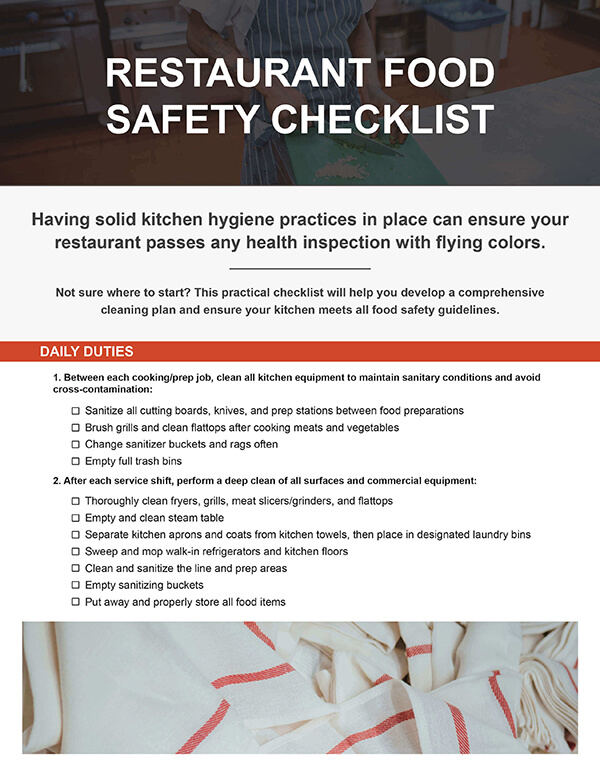January 24, 2020

In the restaurant industry, food safety is a number one priority. Healthy hygiene in commercial kitchens prevents foodborne illnesses and keeps your staff and guests safe. Looking for food safety guidelines for your restaurant? Get tips from our wholesale restaurant food suppliers.
5 Food Safety Best Practices for Restaurants
Every year millions of people get sick from food related illnesses. Many of these illnesses could have been avoided by following safety and hygiene practices in the kitchen. Implementing and maintaining a food safety plan protects your restaurant, employees, and guests from harm. Adhering to your food safety plan also ensures passing marks from routine health inspections. Not sure where to start? Follow these guidelines below.
Be advised, each state has different food safety rules, so be sure to check the regulations in your area.
1. Handwashing
One of the main ways to easily prevent foodborne illness is to ensure all employees keep their hands clean. When should hands be washed in the restaurant? Employees must thoroughly wash their hands between each kitchen related task, and after every break. Staff should scrub their hands in hot soapy water for a minimum of 20 seconds to properly kill off germs and bacteria to prevent cross contamination. Much like surgeons who diligently scrub up before surgery, kitchen personnel should take the same care in soaping up. Post hand washing guidelines at each hand washing station as a reminder to staff.
It is also essential to sanitize all kitchen equipment and surfaces between each prep job and at the end of every shift. This includes:
- Cutting boards, knives, and cooking utensils
- Prep areas, counters, hot and cold lines
- Ovens, stoves, flat tops, and grills
2. Cook Food Thoroughly
It’s always imperative to cook food to its proper internal temperature. Consuming undercooked meat can lead to harmful bacteria, like Salmonella. Cooking foods to their ideal temperature kills off these harmful pathogens. The general rule of thumb for cooking meat is:
- 145°F: Fresh meats and seafood, including:
- Beef, veal, lamb, pork, and fish with fins
- 160°F: Ground meats, including:
- Beef, pork, veal, and lamb
- 165°F: Ground poultry, including:
- Turkey, chicken, and pre-cooked meats such as ham
Calibrate thermometers regularly to make sure they are working properly or invest in new food safety technology. For further information regarding the proper cooking temperatures of other meat, seafood, and cooked foods, please refer to the downloadable chart at Foodsafety.gov.
3. Avoid the “Danger Zone”
Food can spoil more rapidly than one might imagine. Bacteria and germs can multiply exponentially in the temperature range of 40°F to 140°F, known as the Danger Zone. A pork loin that has been perfectly cooked to 145°F can become a breeding ground for bacteria in just a short period of time creating dangerous cross contamination or other food safety problems. To prevent food from reaching the Danger Zone:
- Refrigerate or freeze foods within two hours after cooking.
- Thaw all frozen foods under running water in designated food prep sink, walk-in, or microwave.
- Never immediately place hot food directly into your reach-ins or walk-ins.
Keep temperature logs to monitor the internal temps of food upon delivery and during the cooking and cooling processes and invest in new food safety technologies.
4. Prevent Cross-contamination of food
Cross-contamination in a commercial kitchen is a serious potential food safety hazard. Improperly stored food can transfer harmful bacteria to other ingredients nearby. If raw chicken is stored above cooked and chilled tuna salad, there’s a chance raw chicken juices could drip down. As a general rule, cooked food and raw food should never be stored next to each other, and all fridges should follow storage hierarchy rules. Post food safety storage posters near your refrigerators and freezers for easy reference and ensure proper food handling is followed.
5. Create a Food Safety Culture
Ensure that your food safety culture starts at the top, with buy-in from leadership. Demonstrate that food safety is a priority that must be taken seriously by every employee, during every shift, and with every meal. By emphasizing the importance of food safety, your employees will work continuously toward this mission.
Food safety culture starts with leadership, so it’s imperative to demonstrate food safety as a priority. Perform routine inspections, complete safe food handling training on protocols and expectations, and provide the necessary cleaning supplies and equipment for a food safe kitchen.
US Foods cHEF'STORE, Your Local Wholesale Restaurant Supply Partner
CHEF'STORE provides high-quality products and catering supplies you need for easy one-stop shopping. From restaurant cleaning supplies and products for your commercial kitchen, to our Food Safety Program, we’re committed to exceed your expectations. We invite you to visit your nearest CHEF’STORE today to learn more.
Click to Download the Full Version
